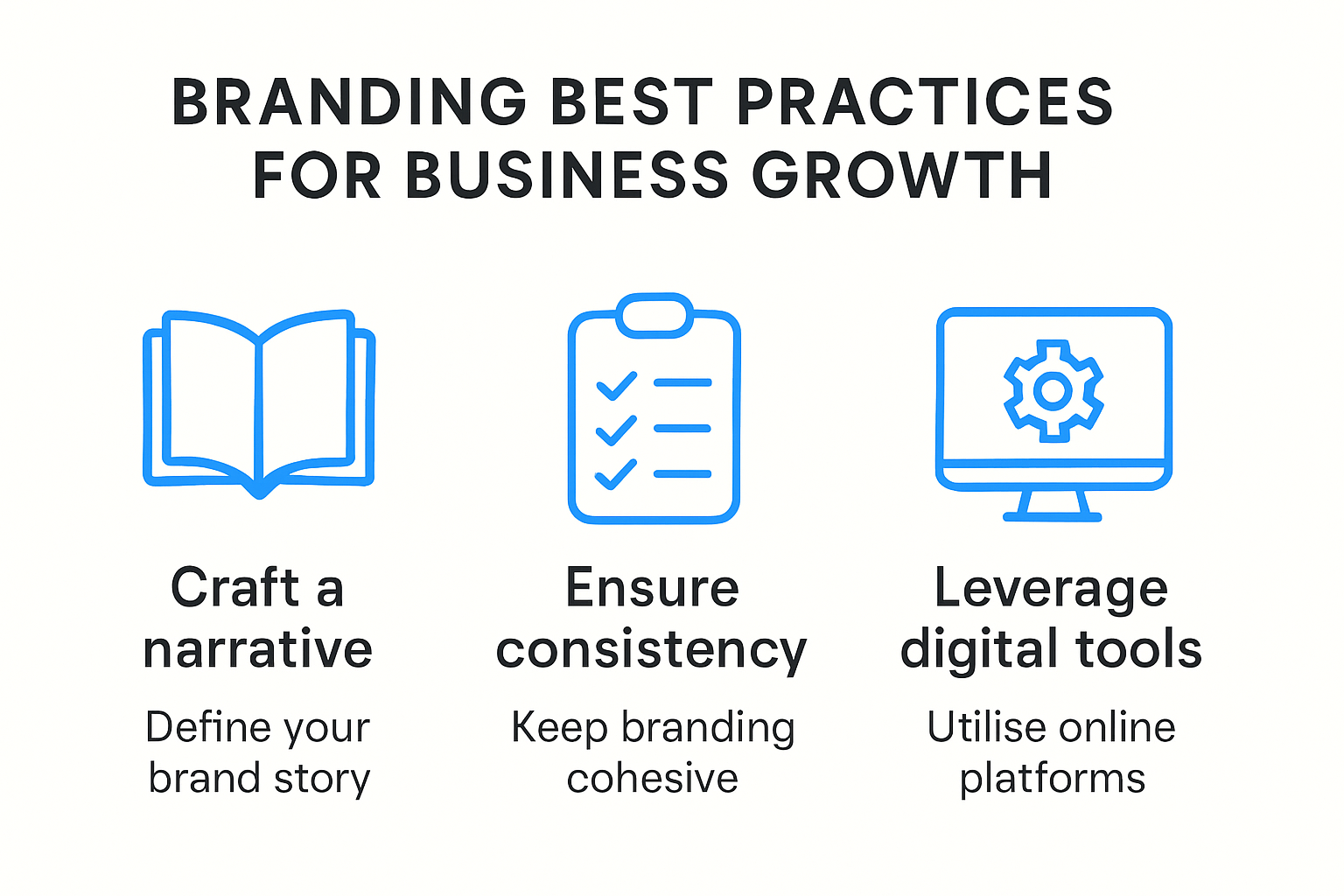Building a brand has never been more competitive, and the pressure to stand out keeps climbing year after year. Strangely enough, even though businesses that prioritise design consistently outperform their competitors by significant margins, most companies still treat branding as just a logo and a tagline. That thinking is holding them back, because the brands that are leading the charge in 2025 are the ones weaving authenticity and digital strategy into every single customer interaction.
Table of Contents
- Building A Strong Brand Identity
- Crafting A Consistent Brand Experience
- Leveraging Digital Tools For Branding Success
- Adapting Branding Strategies For Global Audiences
Quick Summary
| Takeaway | Explanation |
|---|---|
| Craft a compelling brand narrative | Authentic stories create deep connections with customers, enhancing loyalty and trust. |
| Ensure multi-channel brand consistency | Uniform branding across all platforms reinforces identity and builds immediate customer trust. |
| Leverage AI for branded communications | AI tools help create tailored messaging and streamline content generation for better engagement. |
| Adapt branding strategies for global markets | Understanding cultural nuances leads to effective messaging and improves brand acceptance internationally. |
| Develop flexible brand design systems | Modular branding allows for local adaptations while maintaining overall brand identity, appealing to diverse audiences. |

Building a Strong Brand Identity
Crafting a Memorable Brand Narrative
A powerful brand identity starts with a compelling narrative that resonates deeply with your target audience. This goes beyond superficial marketing tactics and requires a genuine understanding of your business’s core values, mission, and the specific problems you solve for customers. Harvard Business Review suggests that purpose-driven brands are more likely to build meaningful connections and inspire customer loyalty.
Successful brand narratives typically incorporate several key elements:
- Authenticity: Communicate your true organisational values
- Consistency: Maintain a uniform message across all platforms
- Emotional Resonance: Create stories that trigger genuine emotional responses
Visual and Verbal Brand Positioning
Brand identity encompasses both visual design and communication strategy. Your visual elements like logos, colour palettes, and typography should create an immediate, recognisable impression. According to Design Management Institute, companies that prioritise design consistently outperform their competitors by significant margins.
Verbal branding is equally critical. This includes your brand voice, messaging tone, and the language you use across marketing materials, website content, and customer interactions. The goal is to develop a distinctive communication style that feels authentic and aligns with your brand’s personality.
Strategic Brand Development Approach
Building a robust brand identity requires a strategic, multifaceted approach. This involves deep market research, understanding your target audience’s preferences, and continuously refining your brand positioning. Key steps include:
- Conducting comprehensive audience research
- Developing a clear brand positioning statement
- Creating comprehensive brand guidelines
Remember that brand identity is not static. It should evolve with changing market dynamics, customer expectations, and your business’s growth trajectory. Regular assessment and strategic refinement ensure your brand remains relevant and compelling in a competitive digital ecosystem.
By investing time and resources into developing a distinctive, authentic brand identity, businesses can create lasting impressions, build customer trust, and establish a strong foundation for sustainable growth.
Below is a table summarising the core elements and steps for building a strong brand identity, helping readers quickly grasp the main requirements discussed in this section.
| Element / Step | Purpose |
|---|---|
| Authenticity | Reflect true organisational values |
| Consistency | Uniform message across all platforms |
| Emotional Resonance | Create strong emotional connection |
| Visual Alignment | Immediate recognition through logos, colours, typography |
| Verbal Positioning | Develop distinctive voice and tone |
| Audience Research | Understand target group needs and preferences |
| Brand Position Statement | Clearly define the brand’s unique position |
| Comprehensive Brand Guidelines | Align teams on implementation and presentation |
Crafting a Consistent Brand Experience
Consistent brand experience represents the strategic alignment of visual, verbal, and emotional touchpoints that create a unified perception of your business across multiple platforms and interactions. This holistic approach ensures that customers receive a seamless and recognisable brand encounter, regardless of where or how they engage with your organisation.
Multi-Channel Brand Synchronisation
Modern businesses must create a harmonised brand experience that transcends individual platforms. Northern Arizona University emphasises that maintaining consistent branding across all domains reinforces brand identity and helps establish immediate visitor trust.
Effective multi-channel synchronisation involves:
- Visual Consistency: Uniform colour schemes, typography, and design elements
- Messaging Alignment: Consistent tone, language, and communication style
- Emotional Resonance: Uniform brand personality across digital and physical interactions
Digital Brand Experience Architecture
Digital platforms demand meticulous brand experience design. Each digital touchpoint represents an opportunity to reinforce your brand’s unique value proposition. Enterprise E-Learning Hub highlights the importance of regular brand audits to ensure alignment between visual elements, voice, tone, and content guidelines.
Key considerations for digital brand experience include:
- Responsive design that maintains brand integrity across devices
- Consistent user interface and interaction patterns
- Streamlined navigation that reflects brand personality
Strategic Brand Experience Management
Brand experience management is an ongoing process requiring continuous monitoring and refinement. Businesses must develop comprehensive brand guidelines that serve as a north star for all communication and design decisions.
Strategic management involves:
- Creating detailed brand style guides
- Training teams on brand communication protocols
- Implementing regular brand performance reviews
By treating brand experience as a dynamic, integrated system, organisations can create memorable, cohesive interactions that build trust, recognition, and long-term customer loyalty. The goal is not just consistency, but a compelling narrative that resonates across every customer touchpoint.
The following table summarises the main dimensions of a consistent brand experience across different touchpoints to help quickly identify key focus areas.
| Dimension | Description | Example Actions |
|---|---|---|
| Visual Consistency | Uniform look and feel across all channels | Use standard colours, logos, typography |
| Messaging Alignment | Consistent language and tone | Use same slogans, tone on all media |
| Emotional Resonance | Shared emotional appeal and brand personality | Reflect same values in all interactions |
| Digital Architecture | Brand integrity across website, app, and social platforms | Responsive layouts, coherent navigation |
| Brand Guidelines | Firm rules for usage and behaviour | Maintain a brand style guide |
| Performance Management | Continuous monitoring and improvement | Regular brand audits and reviews |
Leveraging Digital Tools for Branding Success
In the digital age, businesses have unprecedented access to powerful technological tools that can transform their branding strategies. The convergence of artificial intelligence, data analytics, and advanced design platforms has created a revolutionary landscape for brand development and marketing.
AI-Powered Branding Solutions
Artificial intelligence is reshaping how businesses approach branding and marketing. Research from the ACAI for SBOs study reveals that AI-powered tools can significantly assist small business owners in creating more targeted and effective brand communications. These intelligent systems offer capabilities that go beyond traditional marketing approaches.
Key AI branding capabilities include:
- Automated Content Generation: Creating consistent brand messaging
- Personalisation at Scale: Tailoring brand experiences to individual customer preferences
- Predictive Analytics: Understanding brand perception and market trends
Digital Design and Brand Visualization
Modern digital tools have democratised brand design, allowing businesses to create professional-grade visual identities with unprecedented ease. The research on Generative AI Design Spaces highlights how structured interfaces in generative AI systems can help businesses achieve precise brand alignment, particularly benefiting organisations with limited design resources.
Emerging digital design trends focus on:
- Advanced design platforms with intuitive interfaces
- AI-assisted design recommendations
- Real-time brand asset generation
Strategic Marketing Automation
Advanced digital platforms are transforming marketing management through intelligent automation. Research on Large Language Models demonstrates how these technologies can provide real-time customer insights, automate content creation, and enhance personalisation strategies.
Strategic marketing automation offers businesses:
- Enhanced customer segmentation
- Dynamic content adaptation
- Predictive customer engagement models
The future of branding lies in understanding and strategically leveraging these digital tools. Businesses that embrace technological innovation can create more responsive, engaging, and adaptive brand experiences. By combining human creativity with advanced digital capabilities, organisations can develop brand strategies that are not just reactive, but proactively anticipate market dynamics and customer expectations.
Successful digital branding is no longer about using tools, but about integrating them seamlessly into a comprehensive, strategic approach that reflects your unique organisational identity.
Adapting Branding Strategies for Global Audiences
In an increasingly interconnected world, businesses must develop branding strategies that transcend geographical and cultural boundaries. Global audience engagement requires a nuanced approach that balances universal brand identity with cultural sensitivity and local relevance.
Understanding Cultural Complexity
Thunderbird School of Global Management emphasises the critical importance of recognising cultural nuances when marketing to diverse audiences. Successful global branding goes beyond mere translation, demanding a deep understanding of local values, communication styles, and cultural preferences.
Key considerations for cultural adaptation include:
- Visual Symbolism: Understanding how colours, imagery, and design elements are perceived differently across cultures
- Communication Tone: Adapting messaging to align with local communication norms
- Cultural Sensitivities: Avoiding potentially offensive or misunderstood representations
Flexible Brand Design Systems
Rocky Mountain College of Art + Design highlights the necessity of creating flexible design systems that can be seamlessly adapted across different markets. This approach involves developing modular brand components that maintain core identity while allowing localized customisation.
Strategic design flexibility encompasses:
- Reusable visual elements
- Adaptable brand guidelines
- Localized content frameworks
Strategic Global Brand Positioning
Forbes Agency Council suggests that successful global branding requires a delicate balance between maintaining a consistent core identity and allowing strategic local adaptations. This means developing a universal brand essence that can be interpreted and expressed through culturally relevant approaches.
Effective global brand positioning strategies include:
- Developing universal brand values
- Creating locally relevant marketing initiatives
- Building strategic local influencer partnerships
The most successful global brands understand that true cultural adaptation is not about changing who you are, but about communicating your core identity in ways that resonate authentically with diverse audiences. This requires continuous learning, genuine respect for cultural differences, and a commitment to meaningful cross-cultural communication.
By approaching global branding as a nuanced dialogue rather than a one-size-fits-all strategy, businesses can create meaningful connections that transcend geographical boundaries and build lasting, inclusive brand relationships.
Frequently Asked Questions
What are the key elements of a strong brand identity?
A strong brand identity includes authenticity, consistency, emotional resonance, visual alignment, verbal positioning, audience research, a brand position statement, and comprehensive brand guidelines.
How can businesses ensure consistent branding across multiple channels?
Businesses can ensure consistent branding by maintaining visual and messaging alignment across all platforms, using uniform colour schemes, logos, and tone, and regularly auditing their brand experience.
What role does AI play in modern branding strategies?
AI plays a significant role in automating content generation, personalising brand experiences at scale, and providing predictive analytics to understand customer perceptions and market trends.
How can companies adapt their branding for global audiences?
Companies can adapt their branding for global audiences by understanding cultural nuances, creating flexible brand design systems, and strategically positioning their brand to resonate with local values while maintaining a consistent core identity.
Ready to Elevate Your Brand Identity for 2025 Growth?
For many businesses, turning a compelling brand narrative into a consistent and memorable digital experience is a real challenge. You might feel overwhelmed by the need to keep your visuals and messaging in sync across every platform, while also ensuring your brand strategy keeps up with rapid digital change. As this article highlights, integrating modern branding tools, maintaining authenticity, and aligning every online touchpoint are now essential for business growth in 2025.
Stop letting fragmented strategies hold you back. Cloudfusion combines full-service branding, web development and digital marketing to help South African businesses build identities that truly resonate. Take action before your brand falls behind. Start by exploring how our custom web design and development solutions can give your business the unified digital foundation it needs. Looking for strategic support or a personalised roadmap? View our full offering at Cloudfusion and request your quote today.








